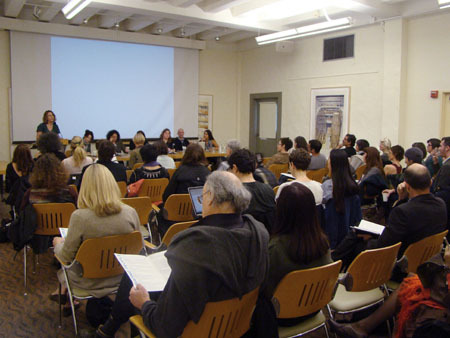
My own notes are my personal interpretations of points raised by our speakers, but here is an attempt to share a few paraphrases of some of the things that made me do some extra scribbling. Others should feel free to add phrases and paraphrases that they remember—or correct mine.
Angela Mattox: how can different organizations make use of each others’ resources to support an artist?…there is an art to the practical…
Erin Doughton: representing the Portland Institute for Contemporary Art not of contemporary art…When we talk about ‘community,’ I mean “us” as part of that community. Community isn’t a codeword for something else… our Time-Based Arts festival abbreviates to TBA…our theatre tech crew all came from working on ships.
Betti-Sue Hertz: the stage and the exhibit hall both all in crisis…the use of the curtain in the visual art exhibition as a way to think about …my partners are international, and curators often function as the broker between our local audience and a wider international conversation
David Henry: the Walker was heaven… Performance was a central part of the city plan to widen the reach of the ICA in Boston…never under-estimate the power of the registrar…artists are more fun to work with than agents…we could also have another conversation about what kind of performance work visual art curators are drawn to and what kind of performance work performance curators are drawn to…
Kristan Kennedy: my first experience with PICA was when i protested the organization…subverting process is central to what the institution is…look around and you’ll realize that Brody Condon is over there reading Brecht…against the idea of a curator as an arbiter of taste
Trinh Minh-ha: l’autre marche translates as an other walk and the other is walking…what it means to require the walker in a museum to stop, linger, and alter the usual pattern for moving in a museum
Connie Lewallen: there used to be 15 to 17 alternative sites devoted to performance work in San Francisco…[FABULOUS SLIDES]…several curators really took an interest in performance [FABULOUS SLIDES]…a lot of the great performance work of the seventies was supported by B.A.M…[FABULOUS SLIDES]…there was much innovative work of course that happened in San Francisco with no support…[FABULOUS SLIDES]…
Susan Miller: …some artists I like…artists whose practice developed from working in the San Francisco scene…New Langton was entirely an artist-run, artist-curated space
Tony Labat: …some said that this was a time when artists stopped doing what they were good at doing…remember Paul McCarthy who said that art experiments are created in San Francisco, packaged in L.A., and sold in New York…we thought that starting a non-profit was going to mean having to do a bunch of things that we didn’t feel like doing, so we funded the work by selling beer at the events…we drank alot of beer
Stephen Tourell: Tom Marioni ran the Museum of Conceptual Art from 1970 to 1984; I consider that a success…believe it or not, the title Performance Art Institute had never been registered before October 2009…the O-Visa is the way to expand international residencies for artists in San Francisco
Lucinda Childs: Sol LeWitt did not want to create a background for dancers—why would that be an interesting thing to do, he said—so we agreed that dancers would function as “the decor” for the work…so to speak…an example of a problem that I give my students in studio? OK, “do a three-count phrase followed by a four-count phrase followed by a five-count phrase…”
